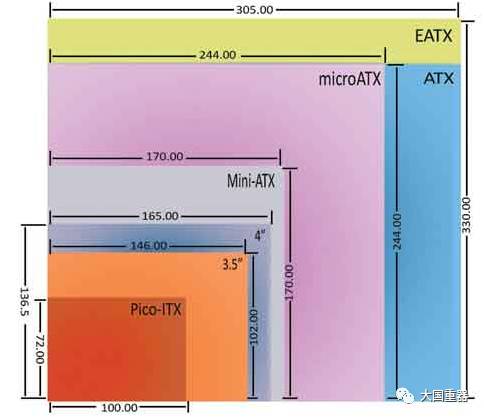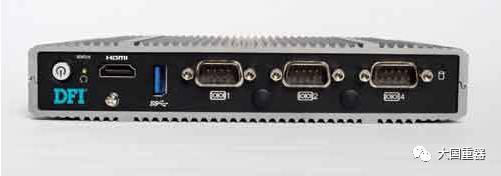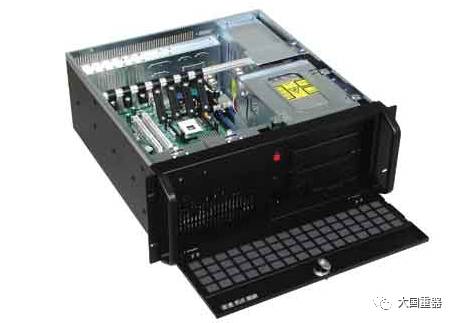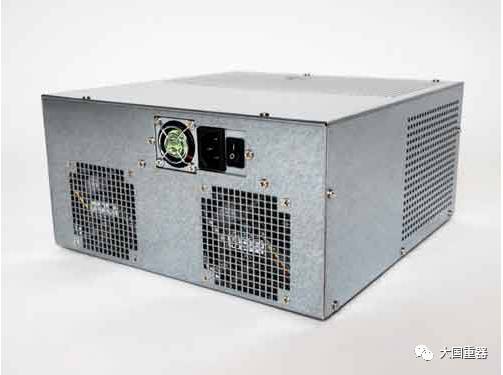
When designing an embedded computer, the architecture may just be a minor issue for designers. As long as there is a processor with certain performance, input/output (I/O), expansion, and other critical ports, the application requirements can be met. Size, weight, power consumption (SwaP), and reliability are key issues, and the motherboard size and shape are also very important.
Motherboard
The ideal motherboard size can provide a more optimizedSwaP for the system. The smaller the motherboard size, the lighter the weight, and the less power consumption, but performance will also be limited. If system space is limited, a trade-off must be made between motherboard size and performance.ATX,EATX,Mini-ITX, andMicroATX embedded motherboards offer various size options.
Mini-ITX motherboards are the most compact and come with up to1 expansion slot, allowing for Intel’s Atom series or Core series low-power processors, typically featuring a smaller CPU socket and lower pin count, as desktop processors have higher requirements for sockets, pins, and thermal power, making them unsuitable for this situation.
MicroATX motherboards have up to four expansion slots, primarily used for desktop processors and other high-power hosts.
ATX performance is very similar to that of products from Meike Company, with expansion capability increased to7 slots.
EATX has the largest specifications and the same number of slots, but currently only allows for dual-processor installations. The dual-processor configuration greatly enhances processing power and can expand other functions, such as memory capacity and the number of bus and interface standards (PCIe) channels.

Figure 1 Different motherboard sizes based on bus and interface standards (by form factor)
In terms of input/output, there is not much difference in port count among different sized motherboards, usually having several display ports, Universal Serial Bus (USB), Local Area Network (LAN), and serial communication ports (COM), supporting standard peripherals and network communication. If the motherboard is primarily for embedded applications, it may include input/output ports such as Linear Power Control Unit (LPC), Internal Integration Circuit (I2C), and Digital Input Output (DIO) for device communication in specific applications. Meanwhile, memory size varies with the increase inSATA port numbers.Mini-ITX motherboards will have2~4 ports, whileEATX motherboards can have up to10.
 Figure 2: Small fanless systems using Mini-ITX motherboards can typically meet military/aviation application environmental and shock/vibration requirements
Figure 2: Small fanless systems using Mini-ITX motherboards can typically meet military/aviation application environmental and shock/vibration requirements
Processor
In addition to motherboard types, an important consideration for applications in the military/aviation field is the processor, which typically provides maximum performance for its application with minimal power consumption. Intel’s Core i series processors, Xeon series, and Atom series provide a unique platform basis.
Intel’s Core i series is the “racing engine”, with very high performance, typically2 to4 cores, up to16 bus and interface standard channels, providing strong throughput for less complex systems without requiring a lot of onboard memory. Intel’s Skylake processors are very fast, typically reaching3-4 GHz, which is very beneficial for many military/aviation signal processing applications, simulation systems, etc.
Xeon processors are similar to “18-wheel half engines”, not necessarily very fast, but capable of driving very large loads. The number of processor cores can be many, with some very high-end applications reaching20 cores. It typically has32 bus and interface standard (PCIe) channels, sometimes reaching40 or more, greatly enhancing flexibility. This design provides motherboard manufacturers with multiple options. Military/aviation designers use Xeon processors in many applications, such asC4ISR systems or situational awareness, server types.
Another type is the low-power processor, such as the Atom series processors. This processor is like a “compact electric car engine”, designed specifically for low power, but with lower versatility, suitable only for systems with only1-4 bus and interface standard (PCIe) channels and low complexity. These systems typically have1-2 cores and are very energy efficient. Motherboard designers also favor small-sized Atom processors due to the system-on-chip design of Atom processors, which reduces the need for chipsets, thus occupying less board space. Intel’s Atom series is suitable for fanless or conduction-cooled military/aviation applications, with significant advantages in mean time between failures (MTBF), simplicity, low power consumption, etc.
 Figure 3 19 inch rack-mounted computers can be highly versatile with ATX or EATX motherboards, along with rich program storage units, airflow configurations, and input/output and expansion options
Figure 3 19 inch rack-mounted computers can be highly versatile with ATX or EATX motherboards, along with rich program storage units, airflow configurations, and input/output and expansion options
Chassis Solutions
For many military/aviation applications, fanless system design is very important, significantly reducing airflow ventilation or the impact of sand, dust, or other contaminants. For low-power multiple-sized motherboards, designers can adopt a variety of fanless chassis configurations to optimizeSWaP, ensuring system longevity. Designers can also make modifications to meet application needs. For example, antennas or wireless network cards can typically be connected to theseSFF computers. See Figure2 for examples of such systems.
Many military/aviation applications require some expansion options. For small systems, this can be achieved, but is typically limited. For example, a small Mini ITX motherboard is170 mmX170 mm, with only one bus and interface standard expansion slot available, but can add one or two tiny bus and interface standard slots. Motherboard systems can provide several slots for adding graphics processing, data acquisition, external expansion/input output, networking, and all types of cards, and also facilitate various standard input output options for serial communication ports (COM), local area network (LAN), serial, video graphics array/integrated digital display interfaces.
Rack-mounted designs provide substantial expansion capacity and rich input/output options for intensive system applications. Figure3 shows a typical configuration of an ATX motherboard inside a rack-mounted computer, featuring front fans,7 rear slots, a single700 watt program storage unit, and dual hot-swappable fans. To increase application versatility, designers can offer various Ethernet, video graphics array (VGA), interactive digital video systems (DVI), high-definition multimedia interfaces, universal serial buses (USB), serial and other ports.
Multi-functional systems are a great example of achieving rack-mounted installation in small systems. These systems usually provide functional expansion, but in more compact wall-mounted systems, Figure4 shows bus and interface standard/ peripheral component expansion interface slots,32GB DDR4 memory, optional optical drives, and multiple graphics, input/output and communication port options for multi-functional system examples.
 Figure 4: When more expansion is needed, multi-functional systems provide versatility in installation options and capabilities
Figure 4: When more expansion is needed, multi-functional systems provide versatility in installation options and capabilities
Single Board Computers
Due to considerations for very small form factors, Single Board Computers (SBC) can be used in many military/aviation systems. It is worth noting that what is referred to here is a small motherboard, not a single board computer based on a backplane system. Single Board Computers integrate multiple board functions into one board. Typically, superior processing capabilities can be combined with graphics processing, multiple input output options, graphics and storage ports, along with excellent DDR3 or DDR4 memory. Xeon, Atom, or Core i processors (and various chipsets) can support various applications. For very small and relatively simple solutions, Atom processors can be used on3.5 inch Single Board Computers, providing a standalone, compact, low-power system for basic computing functions with display ports and various input/output interfaces.
Due to their small size, Single Board Computer circuit boards typically use lower power processors, making them suitable for fanless and conduction-cooled systems. Designers can create very small form factors around Single Board Computers and Embedded Computing Modules (COM Express), without taking up too much space. Figure5 shows an example of a 3.5 inch Single Board Computer with a wrapped shell around it. The Single Board Computer measures146 mm ×102 mm, and due to the addition of space for fans and others, the case size is166 mm ×157 mm. It is worth noting that label mounting slightly increases dimensions. Therefore, using the “exact size” of the chassis can optimize size and weight.

Figure 5: Using a 2.5-4 inch Single Board Computer motherboard’s compact size, the “exact size” chassis connected to the circuit board’s input/output configuration can optimize size, weight, and power
Embedded Computer Modules
COM Express is a module and carrier board pair, allowing applications to specify the size and shape of the motherboard. The module handles all processing-related functions, while the carrier board handles input output and expansion. To illustrate with a “car engine” analogy, the embedded computer module contains the engine, transmission, and drivetrain, while the carrier board is the vehicle’s chassis. Essentially, the module is used to process the processor and memory, providing an interface to the carrier board in the form of standard connectors. Through this dual-board approach, military/aviation designers are able to apply embedded computers more flexibly. The carrier board can be easily customized according to various input/output and expansion requirements while remaining consistent with the module board. Over time, the performance of the module can be upgraded and will continue to connect with the carrier board. Through standard interfaces between the carrier and module, various embedded computers and manufacturing facilities can utilize them over time. This solution can also keep the carrier board design confidential.
Embedded computer modules are very versatile, with interfaces in several standard sizes including basic, extended, mini, and compact. Because the basic and extended versions are larger, they typically have more powerful Intel Core i processors. To provide more versatility, embedded computer module designers can leverage the best cost-performance ratio of various generations of processors, such as compact and mini modules typically using system-on-chip-based Core i or Atom processors. Of course, the key factor for the capabilities of embedded computer modules is the different types. Version6 of the embedded computer module can offer up to24 bus and interface standard channels, which is currently the most common channel. Each type of embedded computer module defines the number of bus and interface standard channels that can be used as the number of available input/output ports.
Chassis Versatility
Generally, commercial or industrial-grade rack-mounted chassis are suitable for defense computing, but sometimes a more robust design is needed. To make commercial industrial rack-mounted chassis more robust, designers can make partial modifications. Designers need to select appropriate components to operate/store temperature and withstand environmental impacts. Additionally, conformal coatings can be used to protect components in the system. By using materials from cold-rolled steel to aluminum and thickened reinforcement points, the chassis can be strengthened and lightened. Designers can use compression rods to secure modules to slots and other fasteners/dampers to meet higher levels of shock and vibration. System redundancy is another concern for high-reliability systems, which can also achieve power redundancy with voltage/health monitoring options.
Having various chassis depth options can help users optimize the size and weight of the chassis. For example, utilizing special mounting regulations and universal design methods, this computing platform can undergo significant changes to dual-redundant program storage units and rear drive bays through wiring or customization.
Other Considerations
Besides design, another key factor in providing computing platforms for defense and government applications is long lifecycle. This is mainly influenced by consumer choices of embedded motherboards. Regarding assurance issues, consumers are concerned about their usability for years or decades. Users having to choose a new board means costly hardware re-certification and the time lost. Not to mention, this is entirely unacceptable for mission-critical applications. Embedded motherboards have longer lifecycle support. Revision control is also a consideration, as consumer motherboards will change components based on what is available and most cost-effective at the time of manufacturing. Embedded motherboards can lock material bills of materials (BOM) and inventory parts according to the project’s lifecycle. Providing extended lifecycle support for central processing units (CPU) and other components is important for defense requirements.
